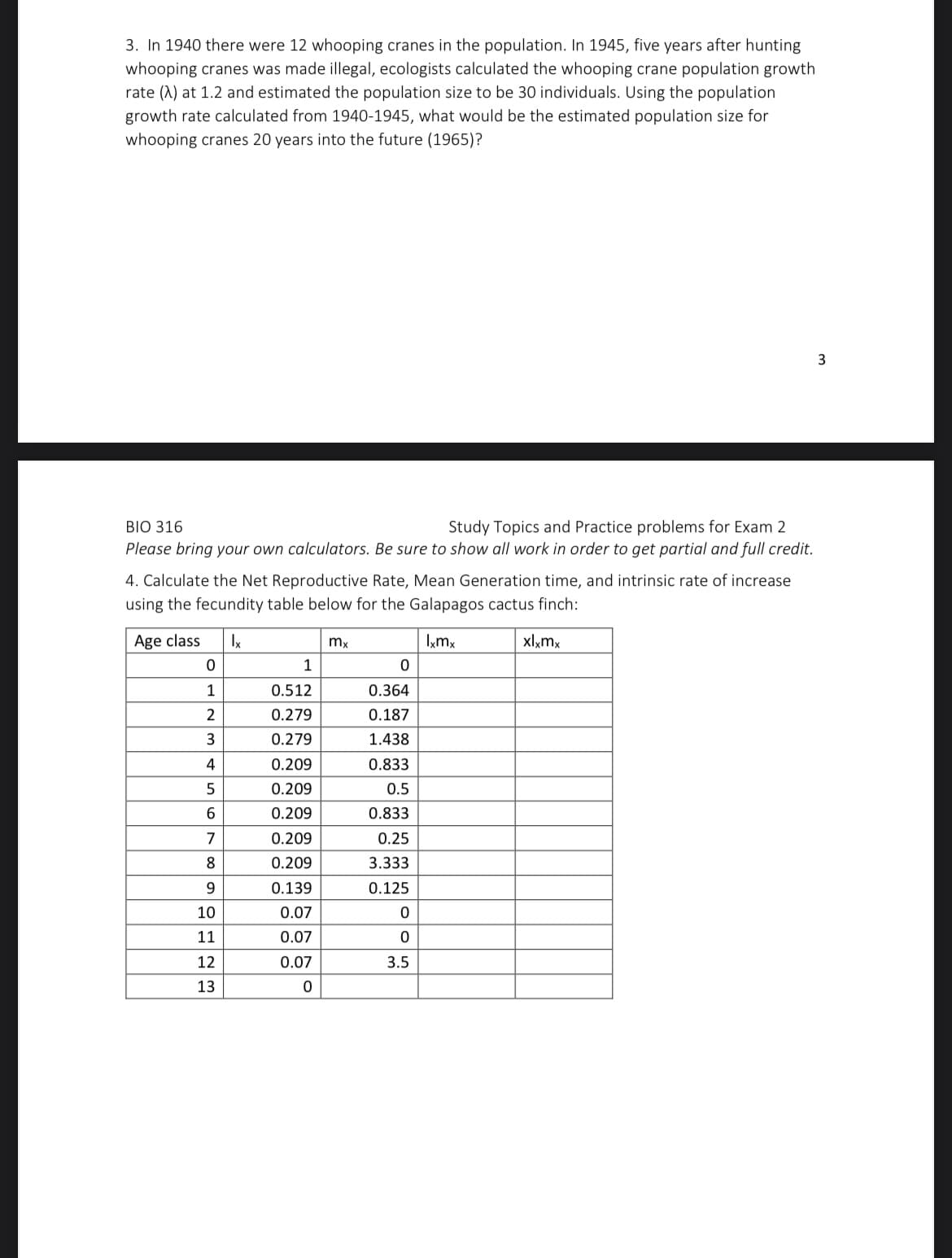3. In 1940 there were 12 whooping cranes in the population. In 1945, five years after hunting whooping cranes was made illegal, ecologists calculated the whooping crane population growth rate (X) at 1.2 and estimated the population size to be 30 individuals. Using the population growth rate calculated from 1940-1945, what would be the estimated population size for whooping cranes 20 years into the future (1965)? BIO 316 Study Topics and Practice problems for Exam 2 Please bring your own calculators. Be sure to show all work in order to get partial and full credit. 4. Calculate the Net Reproductive Rate, Mean Generation time, and intrinsic rate of increase using the fecundity table below for the Galapagos cactus finch: Age class lx mx lxmx 0 1 0 1 0.512 0.364 2 0.279 0.187 3 0.279 1.438 4 0.209 0.833 10 567890 0.209 0.5 0.209 0.833 0.209 0.25 0.209 3.333 0.139 0.125 0.07 0 11 0.07 0 12 0.07 3.5 13 0 xlxmx 3
3. In 1940 there were 12 whooping cranes in the population. In 1945, five years after hunting whooping cranes was made illegal, ecologists calculated the whooping crane population growth rate (X) at 1.2 and estimated the population size to be 30 individuals. Using the population growth rate calculated from 1940-1945, what would be the estimated population size for whooping cranes 20 years into the future (1965)? BIO 316 Study Topics and Practice problems for Exam 2 Please bring your own calculators. Be sure to show all work in order to get partial and full credit. 4. Calculate the Net Reproductive Rate, Mean Generation time, and intrinsic rate of increase using the fecundity table below for the Galapagos cactus finch: Age class lx mx lxmx 0 1 0 1 0.512 0.364 2 0.279 0.187 3 0.279 1.438 4 0.209 0.833 10 567890 0.209 0.5 0.209 0.833 0.209 0.25 0.209 3.333 0.139 0.125 0.07 0 11 0.07 0 12 0.07 3.5 13 0 xlxmx 3
Biology: The Dynamic Science (MindTap Course List)
4th Edition
ISBN:9781305389892
Author:Peter J. Russell, Paul E. Hertz, Beverly McMillan
Publisher:Peter J. Russell, Paul E. Hertz, Beverly McMillan
Chapter52: Population Ecology
Section: Chapter Questions
Problem 5TYK
Related questions
Question

Transcribed Image Text:3. In 1940 there were 12 whooping cranes in the population. In 1945, five years after hunting
whooping cranes was made illegal, ecologists calculated the whooping crane population growth
rate (X) at 1.2 and estimated the population size to be 30 individuals. Using the population
growth rate calculated from 1940-1945, what would be the estimated population size for
whooping cranes 20 years into the future (1965)?
BIO 316
Study Topics and Practice problems for Exam 2
Please bring your own calculators. Be sure to show all work in order to get partial and full credit.
4. Calculate the Net Reproductive Rate, Mean Generation time, and intrinsic rate of increase
using the fecundity table below for the Galapagos cactus finch:
Age class
lx
mx
lxmx
0
1
0
1
0.512
0.364
2
0.279
0.187
3
0.279
1.438
4
0.209
0.833
10
567890
0.209
0.5
0.209
0.833
0.209
0.25
0.209
3.333
0.139
0.125
0.07
0
11
0.07
0
12
0.07
3.5
13
0
xlxmx
3
Expert Solution
This question has been solved!
Explore an expertly crafted, step-by-step solution for a thorough understanding of key concepts.
Step by step
Solved in 1 steps

Recommended textbooks for you

Biology: The Dynamic Science (MindTap Course List)
Biology
ISBN:
9781305389892
Author:
Peter J. Russell, Paul E. Hertz, Beverly McMillan
Publisher:
Cengage Learning

Biology: The Unity and Diversity of Life (MindTap…
Biology
ISBN:
9781337408332
Author:
Cecie Starr, Ralph Taggart, Christine Evers, Lisa Starr
Publisher:
Cengage Learning

Biology: The Unity and Diversity of Life (MindTap…
Biology
ISBN:
9781305073951
Author:
Cecie Starr, Ralph Taggart, Christine Evers, Lisa Starr
Publisher:
Cengage Learning

Biology: The Dynamic Science (MindTap Course List)
Biology
ISBN:
9781305389892
Author:
Peter J. Russell, Paul E. Hertz, Beverly McMillan
Publisher:
Cengage Learning

Biology: The Unity and Diversity of Life (MindTap…
Biology
ISBN:
9781337408332
Author:
Cecie Starr, Ralph Taggart, Christine Evers, Lisa Starr
Publisher:
Cengage Learning

Biology: The Unity and Diversity of Life (MindTap…
Biology
ISBN:
9781305073951
Author:
Cecie Starr, Ralph Taggart, Christine Evers, Lisa Starr
Publisher:
Cengage Learning

Biology 2e
Biology
ISBN:
9781947172517
Author:
Matthew Douglas, Jung Choi, Mary Ann Clark
Publisher:
OpenStax